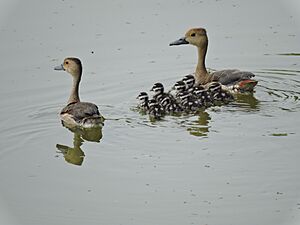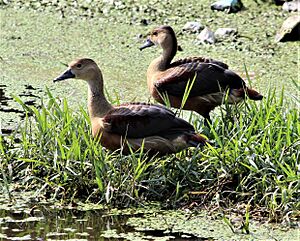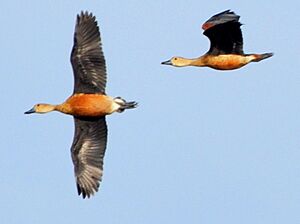Lesser whistling duck facts for kids
Quick facts for kids Lesser whistling duck |
|
|---|---|
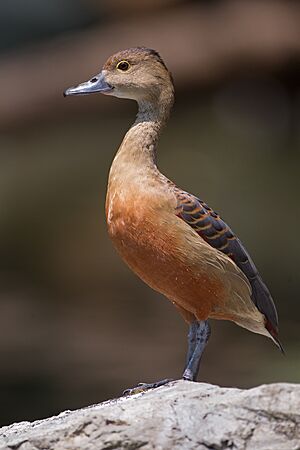 |
|
| In Chiang Mai Province, Thailand | |
| Conservation status | |
| Scientific classification | |
| Genus: |
Dendrocygna
|
| Species: |
javanica
|
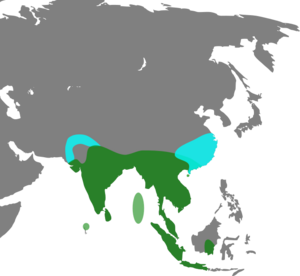 |
|
| Resident range in green and summer range in blue | |
The lesser whistling duck (Dendrocygna javanica), also known as the Indian whistling duck or lesser whistling teal, is a type of whistling duck. These ducks live in the Indian subcontinent and Southeast Asia. They are active at night, looking for food. During the day, you can often find them in groups around lakes and wet paddy fields.
These ducks can even sit on trees and sometimes build their nests in tree hollows. This duck is brown with a long neck and wide wings. When it flies, it makes a loud, wheezy two-note call. You can tell it apart from its larger cousin, the fulvous whistling duck, because it has a chestnut-colored rump (the back part), while the fulvous duck has a creamy white rump.
Contents
What Does the Lesser Whistling Duck Look Like?
This duck is mostly chestnut brown. It looks a lot like the fulvous whistling duck (D. bicolor). However, the lesser whistling duck has chestnut-colored feathers on its upper tail. The fulvous duck has creamy white ones. The ring around its eye is orange or yellow.
When these ducks fly, they hold their heads lower than their bodies. This is common for other Dendrocygna species. The top of their head looks dark. Both male and female ducks look the same. They fly slowly but flap their wings very fast. As they fly overhead, they often make a repeated, wheezy "seasick" sound. They are mostly active at night and rest during the day.
Where Do Lesser Whistling Ducks Live?
This duck species usually stays in one place. They are found across the lowland wetlands of the Indian subcontinent and Southeast Asia. You can also find them on islands like the Andamans, Nicobars, and Maldives.
Sometimes, they move to different areas if the weather changes or if there isn't enough water. Ducks from northern areas might fly south for the winter. They prefer freshwater wetlands with lots of plants. During the day, they often rest on riverbanks or even on the open sea near coasts.
Young ducklings are black with a white stripe above their eyes. They also have white patches on the back of their heads, wings, lower backs, and rumps. Very rarely, albino ducks (all white) have been seen in the wild.
Behavior and Daily Life
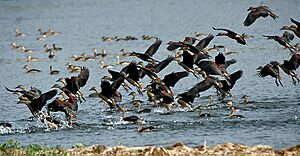
Lesser whistling ducks usually live in groups. They mostly eat plants they find in the water. They also eat grains from rice fields, small fish, frogs, and tiny creatures like molluscs and worms. They can dabble (dip their heads in water) or dive to find food. They often waddle on land. Sometimes, Common myna birds follow them in grassy areas.
Reproduction and Life Cycle
During courtship, the male duck faces the female. He dips and raises his bill in the water and swims around her. They breed during the monsoon or rainy season. The exact timing can change depending on how much food is available.
Their nest might be a hole in a tree, lined with twigs and grass. They might also build a nest in the fork of a large tree. Sometimes, they reuse old nests made by kites or herons. They can even nest on the ground. A female usually lays 7 to 12 white eggs. Both parents take turns sitting on the eggs. Sometimes, very large clutches of up to 17 eggs are found. This might mean that other ducks laid eggs in the same nest. The eggs hatch after about 22 to 24 days. They might raise more than one group of ducklings in a single season. Sometimes, young birds are carried on the backs of their parents.
These ducks are called sili and silhahi in India. These names come from their wheezy two-note calls. They can become very friendly if kept in captivity. They will walk around and respond to whistles. Some captive ducks in the USA have lived for up to 9 years.
Images for kids
-
White-bellied sea eagle (Haliaeetus leucogaster) with captured duck



